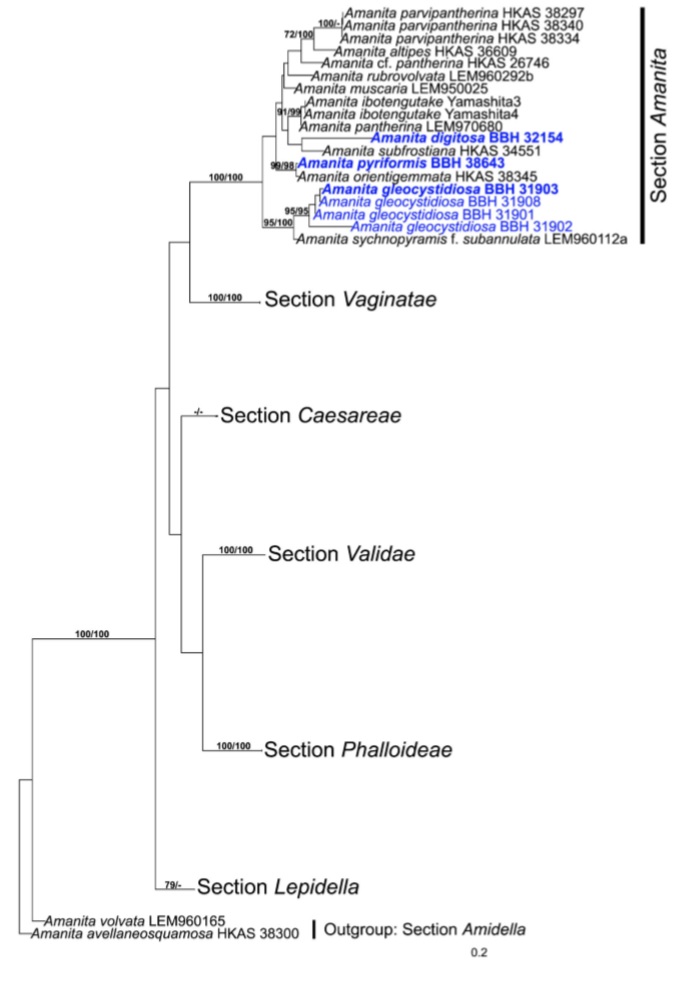Amanita gleocystidiosa Boonprat. & Parnmen
Index Fungorumnumber: IF551614 Faceoffunginumber: FoF 02071
Etymology: The specific epithet refers to Amanita with abundant of yellow gleocystidium, ‘gleocystidium’ (n, neuter=versiform cystidia which have granular content)+‘osus’ (adjA suffix=abundant)
Holotype: BBH31903 Pileus 22–45 mm diam. at first, first convex to parabolic when young, expanding to applanate with age, sometimes depressed, sulcate, sticky, moist, colour ranges from dark brown 8(F)5–8 at disc to grayish yellow 1(A)3–5 at margin when young; olive yellow 2–3(C–E)6–8 at disc to yellowish white 2–3(A)2 at margin with age, sometimes dark brown 8(F)5–8 at disc to grayish yellow 1(A)3–5 at margin with age, with striate and even margin. Pileus context off white, 2–3 mm thick, soft and moist. Lamellae free,broad,average,3 series, sub-distant, yellowish white 2–3(A)2. Stipe 75– 100×6–9 mm, central, tapered from base to apex, clavate bulbous base, fistulose, longtitudinal striate, pale orange to orange white 5(A)2–3 with grayish orange striate 5(B)3–6 after bruising. Annulus with single layer, pale yellow to brown, apical and partial veil still intact when young, many of disappearing with age but few present at a center of stipe. Volva constricted, adherent with flaring margin, white. Basidiospores 7–10 (–11)×7–10μm [x=8.76 ±0.91×8.12±0.13μm,Q=1.07±0.10,n=25 spores per collection, 2 collections], globose subglobose, smooth, hyaline, inamyloid,thin-walled. Basidia 27–41×9.5–12.5μm, clavate 2-spored, clamp connection absent, smooth, hyaline, inamyloid, thin-walled. Basidioles 18–21×6.5–7.5μm, clavate, smooth, hyaline, inamyloid, thin-walled. Pleurocystidia with two types of clavate and lanciolate, smooth, hyaline, inamyloid, thin-walled, clavate pleurocystidia 30–35×7.5– 12.5μm, lanciolate pleurocystidia 35–50×8.5–12.5μm. Cheilocystidia apex 12–13μm×middle 5–7×base 3–4μm, broadly clavate to pyriform, smooth, hyaline, inamyloid, thin-walled. Gleocystidia abundant among basidioles, pleurocystidia and cheilocystidia, shape and size dependent on the position of appearance, contains yellow granules, smooth, hyaline, inamyloid, thin-walled. Lamellae trama divergent,broadly clavate to broadly ellipsoid, smooth, hyaline, dextrinoid,thin-walled, base of hymenial layer directly arising from a few layers of cellular cells,which connects to the trama element. Pileipellis composed of cutis of repent hyphae, smooth, hyaline, inamyloid, thin-walled. Stipilipellis composed with cutis of repent hyphae, 2.5–5μm diam., smooth, hyaline, inamyloid, thin-walled. Stipe trama composed of two types of element: repent hyphae and broadly clavate tobroadly ellipsoid hyphae 73–105×31–34μm, smooth, hyaline, inamyloid, thin-walled. Volva composed of two types of elements: 22–31×3.5–7μm of clavate cells and 14–28×6.3– 11.5μm of broadly clavate to broadly ellipsoid cells, smooth, hyaline, inamyloid, thin-walled. Clamp absent in all parts of basidiomata.
Habitat: Terrestrial in mixed forest.
Material examined: THAILAND, Phetchabun Province, Lom Kao District, Na Sang Tambon, 28 May 2012, collector SRRTTeam, Bureau of Epidemiology, Department of Disease Control Ministry of Public Health (BBH31903, holotype); Ibid., BBH31901, BBH31902 and BBH31908, paratypes, all collections were from Phetchabun Province, Lom Kao District, Na Sang Tambon, collector SRRT Team, Bureau of Epidemiology, Department of Disease Control Ministry of Public Health, 28 May 2012, specimen scattered around temple.
Notes: Amanita gleocystidiosa is similar to A. sychnopyramis f. subannulata Hongo (Yang et al. 2001) in having a similar macroscopic morphology and basidiospore shape and size, but A. gleocystidiosa differs from A. sychnopyramis f. subannulata in having pleurocystidia and cheilocystidia, while those two types of cystidia were absent in A. sychnopyramis f. subannulata. The most important feature in A. gleocystidiosa are gleocystidia containing yellow granular cells, abundantly dispersed among cells in the hymenial layer.

Maximum likelihood tree depicting infrageneric relationships of Amanita based on nuclear ITS dataset. ML and MP bootstrap values≥70 % are shown above branches. Sequences derived from three new toxic species are in bold

Amanita gleocystidiosa (holotype) a (i –ii) Basidiomata b Basidiospores c(i) Basidia c(ii) Basidia with basidioles d Basidiolese(i)Pleurocystidia e(ii) Pleurocystidia and basidioles mixed with gleocystidia in the different shapes f(i) Cheilocystidia f(ii) Cheilocystidia with basidioles g Veil trama. Scale bars: a=10 mm, b– g=10μm
